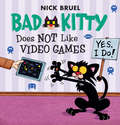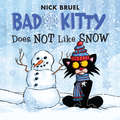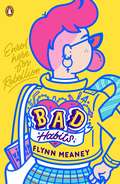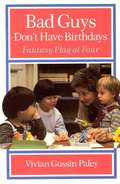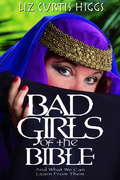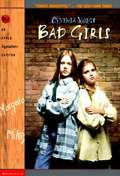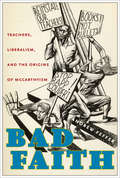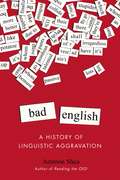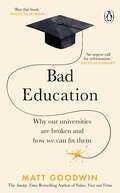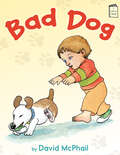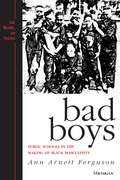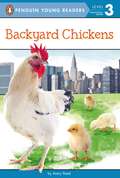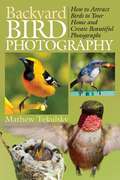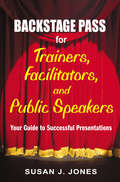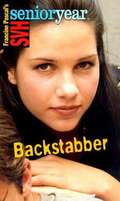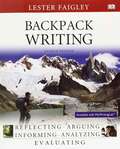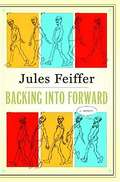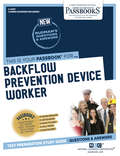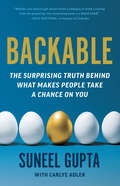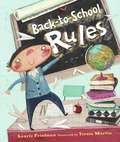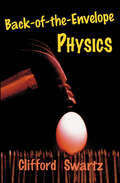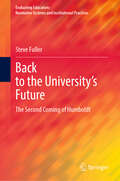- Table View
- List View
Bad Kitty Does Not Like Video Games (Bad Kitty)
by Nick BruelAll Kitty wants to do is play her favorite video game. But Kitty has been playing her video game for FIVE hours. Now it's time for Kitty to:go outside,draw a picture, read a book,do anything other than play video games.Kitty doesn't want to do any of these things. . . but eventually she does anyway, and discovers that some things are way more fun than video games.
Bad Kitty Does Not Like Snow (Bad Kitty)
by Nick BruelIt's snowing. Kitty has never seen snow. So Kitty looks it up on the computer.Snow is wet.Snow is cold.Snow is slippery.Okay. Bad Kitty can handle this. She'll just put on her snow gear and try. . .
Bad Habits
by Flynn Meaney'Heart-warming and hilarious, this is a book you need on your shelves in these bleak times.' Irish TimesPerfect for fans of Sex Education and Derry Girls.Alex is a rebel with a purple fauxhawk and biker boots.St Mary's Catholic School is the strict boarding school where she's currently trapped.Despite trying everything she can to get expelled, she's still stuck with the nuns, the prudish attitude and the sexism. So Alex decides to take matters into her own hands. She's going to stage the school's first ever production of The Vagina Monologues . . .Trouble is, no one else at St Mary's can even bear to say the word 'vagina' out loud!A riotously funny novel about the importance of friendship and finding your voice.
Bad Guys Don't Have Birthdays: Fantasy Play at Four
by Vivian Gussin PaleyBad guys are not allowed to have birthdays, pick blueberries, or disturb the baby. So say the four-year-olds who announce life's risks and dangers as they play out the school year in Vivian Paley's classroom. Their play is filled with warnings. They invent chaos in order to show that everything is under control. They portray fear to prove that it can be conquered. No theme is too large or too small for their intense scrutiny. Fantasy play is their ever dependable pathway to knowledge and certainty. " It . . . takes a special teacher to value the young child's communications sufficiently, enter into a meaningful dialogue with the youngster, and thereby stimulate more productivity without overwhelming the child with her own ideas. Vivian Paley is such a teacher. " Maria W. Piers, in the "American Journal of Education" " Mrs. Paley's books] should be required reading wherever children are growing. Mrs. Paley does not presume to "understand" preschool children, or to theorize. Her strength lies equally in knowing that she does not know and in trying to learn. When she cannot help children because she can neither anticipate nor follow their thinking she strives not to hinder them. She avoids the arrogance of adult to small child; of teacher to student; or writer to reader. " Penelope Leach, author of "Your Baby & Child" in the "New York Times Book Review" " Paley's] stories and interpretation argue for a new type of early childhood education . . . a form of teaching that builds upon the considerable knowledge children already have and grapple with daily in fantasy play. " Alex Raskin, "Los Angeles Times Book Review" "Through the 'intuitive language' of fantasy play, Paley believes, children express their deepest concerns. They act out different roles and invent imaginative scenarios to better understand the real world. Fantasy play helps them cope with uncomfortable feelings. . . . In fantasy, any device may be used to draw safe boundaries. " Ruth J. Moss, "Psychology Today""
Bad Girls of the Bible: And What We Can Learn from Them (Bad Girls of the Bible)
by Liz Curtis HiggsWomen everywhere marvel at those "good girls" in Scripture-Sarah, Mary, Esther-but on most days, that's not who they see when they look in the mirror. Most women (if they're honest) see the selfishness of Sapphira or the deception of Delilah. They catch of glimpse of Jezebel's take-charge pride or Eve's disastrous disobedience. Like Bathsheba, Herodias, and the rest, today's modern woman is surrounded by temptations, exhausted by the demands of daily living, and burdened by her own desires. So what's a good girl to do? Learn from their lives, says beloved humor writer Liz Curtis Higgs, and by God's grace, choose a better path. In Bad Girls of the Bible, Higgs offers a unique and clear-sighted approach to understanding those "other women" in Scripture, combining a contemporary retelling of their stories with a solid, verse-by-verse study of their mistakes and what lessons women today can learn from them. Whether they were "Bad to the Bone," "Bad for a Season, but Not Forever" or only "Bad for a Moment," these infamous sisters show women how not to handle the challenges of life. With her trademark humor and encouragement, Liz Curtis Higgs teaches us how to avoid their tragic mistakes and joyfully embrace grace.
Bad Girls (Bad Girls #1)
by Cynthia VoigtMargalo and Mikey have the same initials and are both new to Washington Elementary. And they have something else in common: both want to be anything but nice. Its not long before Margalo and Mikey turn their classroom into a minefield. No one knows what to expect from two girls who don't behave the way they're supposed to. Two girls who don't take things lying down, and who aren't afraid of anything... except maybe letting someone else get close.
Bad Faith: Teachers, Liberalism, and the Origins of McCarthyism
by Andrew FefferIn late summer 1940, as war spread across Europe and as the nation pulled itself out of the Great Depression, an anticommunist hysteria convulsed New York City. Targeting the city’s municipal colleges and public schools, the New York state legislature’s Rapp-Coudert investigation dragged hundreds of suspects before public and private tribunals to root out a perceived communist conspiracy to hijack the city’s teachers unions, subvert public education, and indoctrinate the nation’s youth. Drawing on the vast archive of Rapp-Coudert records, Bad Faith provides the first full history of this witch-hunt, which lasted from August 1940 to March 1942. Anticipating McCarthyism and making it possible, the episode would have repercussions for decades to come. In recapturing this moment in the history of prewar anticommunism, Bad Faith challenges assumptions about the origins of McCarthyism, the liberal political tradition, and the role of anticommunism in modern American life. With roots in the city’s political culture, Rapp-Coudert enjoyed the support of not only conservatives but also key liberal reformers and intellectuals who, well before the Cold War raised threats to national security, joined in accusing communists of “bad faith” and branded them enemies of American democracy. Exploring fundamental schisms between liberals and communists, Bad Faith uncovers a dark, “countersubversive” side of liberalism, which involved charges of misrepresentation, lying, and deception, and led many liberals to argue that the communist left should be excluded from American educational institutions and political life. This study of the Rapp-Coudert inquisition raises difficult questions about the good faith of the many liberals willing to aid and endorse the emerging Red scare, as they sacrificed principles of open debate and academic freedom in the interest of achieving what they believed would be effective modern government based on bipartisanship and a new and seemingly permanent economic prosperity.
Bad English
by Ammon SheaThe author of Reading the OED presents an eye-opening look at language "mistakes" and how they came to be accepted as correct--or not. English is a glorious mess of a language, cobbled together from a wide variety of sources and syntaxes, and changing over time with popular usage. Many of the words and usages we embrace as standard and correct today were at first considered slang, impolite, or just plain wrong. Whether you consider yourself a stickler, a nitpicker, or a rule-breaker in the know, Bad English is sure to enlighten, enrage, and perhaps even inspire. Filled with historic and contemporary examples, the book chronicles the long and entertaining history of language mistakes, and features some of our most common words and phrases, including: Decimate Hopefully Enormity That/which Enervate/energize Bemuse/amuse Literally/figuratively Ain't Irregardless Socialist OMG Stupider Lively, surprising, funny, and delightfully readable, this is a book that will settle arguments among word lovers--and it's sure to start a few, too.
Bad Education: Why Our Universities Are Broken and How We Can Fix Them
by Matt Goodwin'Buy this book' DOUGLAS MURRAY'An urgent call for reformation’ DAVID GOODHARTTHE EXPLOSIVE NEW BOOK FROM THE SUNDAY TIMES BESTSELLING AUTHOR OF NATIONAL POPULISM AND VALUES, VOICE AND VIRTUE.Depressed tutors and disillusioned students. Funding crises and falling standards. Culture wars and campus protests. Welcome to the broken world of academia. Welcome to Bad Education.-------------------------Our universities are broken. Established as sanctuaries of truth and higher learning, they are now decaying institutions that are failing a generation of young people. Consumed by funding and admissions crises, mired in political scandal and governed by self-interest, their founding principles have been corrupted. This explosive book shows us why, and what we must do to fix them.Matt Goodwin spent decades working as an academic in some of the world’s leading universities, delivering underfunded courses to increasingly disengaged lecture theatres, sitting on rudderless committees, counselling depressed colleagues and concerned students, watching standards slip and academic integrity decline.At the heart of this crisis is an increasingly politicised campus. Once bastions of free speech, forums for open debate and incubators of bold new ideas, our universities are increasingly becoming monocultures, ruled by an ideology that is silencing respected voices, stifling discussion and violently shutting down diverse opinion, betraying intellectual freedom and failing to deliver the very basics of an education.Unflinching, shocking and urgent, this first-hand account provides an insider's view of how the founding principles of academia are in decline and why we should all consider what this means for the students of today, tomorrow and the world they will shape.
Bad Dreams
by Anne FineMel is the class bookworm. She prefers books to people and doesn't want to be a first-week minder for new girl Imogen. But there's something very strange about Imogen and, as Mel slowly uncovers the truth, she begins to realize that stories can happen in real life, too.
Bad Dog (I Like to Read)
by David McPhailBad dog! Tom the dog is being very bad…Can he redeem himself before Dad puts him out in the yard? Loveable rascal Tom the dog is being very bad. He breaks the TV. He chases Kit the cat. He pulls down the tablecloth. Luckily, when Kit goes missing, it takes someone with four legs and a powerful nose to find her. Forgiveness and love triumph in this charming, easy-to-read story of a family dog who is rarely on his best behavior but whose heart is always in the right place.An I Like to Read® book. Guided Reading Level C.The award-winning I Like to Read© series focuses on guided reading levels A through G, based upon Fountas and Pinnell standards. Acclaimed author-illustrators—including winners of Caldecott, Theodor Seuss Geisel, and Coretta Scott King honors—create original, high quality illustrations that support comprehension of simple text and are fun for kids to read with parents, teachers, or on their own!For readers who've mastered basic sight words, Level C books feature slightly longer sentences and a wider range of high-frequency words than Level B books. Level C books are suitable for mid-to-late kindergarten readers. When Level C is mastered, follow up with Level D.
Bad Boys: Public Schools in the Making of Black Masculinity
by Arnett Ferguson<P>Statistics show that black males are disproportionately getting in trouble and being suspended from the nation's school systems. Based on three years of participant observation research at an elementary school, Bad Boys offers a richly textured account of daily interactions between teachers and students to understand this serious problem. <P>Ann Arnett Ferguson demonstrates how a group of eleven- and twelve-year-old males are identified by school personnel as "bound for jail" and how the youth construct a sense of self under such adverse circumstances. The author focuses on the perspective and voices of pre-adolescent African American boys. How does it feel to be labeled "unsalvageable" by your teacher? How does one endure school when the educators predict one's future as "a jail cell with your name on it?" <P>Through interviews and participation with these youth in classrooms, playgrounds, movie theaters, and video arcades, the author explores what "getting into trouble" means for the boys themselves. She argues that rather than simply internalizing these labels, the boys look critically at schooling as they dispute and evaluate the meaning and motivation behind the labels that have been attached to them. Supplementing the perspectives of the boys with interviews with teachers, principals, truant officers, and relatives of the students, the author constructs a disturbing picture of how educators' beliefs in a "natural difference" of black children and the "criminal inclination" of black males shapes decisions that disproportionately single out black males as being "at risk" for failure and punishment. <P>Bad Boys is a powerful challenge to prevailing views on the problem of black males in our schools today. It will be of interest to educators, parents, and youth, and to all professionals and students in the fields of African-American studies, childhood studies, gender studies, juvenile studies, social work, and sociology, as well as anyone who is concerned about the way our schools are shaping the next generation of African American boys.
Bacterial Cellulose: Sustainable Material for Textiles (Sustainable Textiles: Production, Processing, Manufacturing & Chemistry)
by Subramanian Senthilkannan Muthu R. RathinamoorthyThis book presents the potential of bacterial cellulose in the textile and fashion industry. Most of the earlier work on the bacterial cellulose was focused on the bio technology application of cellulose, but the recent urge for the need of a sustainable material in the fashion and textile industries identified the scope of the bacterial cellulose in this aspect. The unique feature of this book is that it relates the bio technological aspects of bacterial cellulose with the sustainable issues in the fashion industry.
Backyard Chickens (Penguin Young Readers, Level 3)
by Avery ReedRaising chickens is becoming more and more popular, as families are opting for organic produce and sustainable lifestyles. This new Level 2 reader is full of photographs and facts to teach kids how they too can have their very own backyard chickens!
Backyard Bird Photography: How to Attract Birds to Your Home and Create Beautiful Photographs
by Mathew TekulskyFans of bird watching will rejoice with Backyard Bird Photography, a guide for learning how to set up your backyard in order to take the best photographs of your local birds. In addition to guiding you through the first steps of setting up your plantings and bird feeders, this book describes the types of photographic equipment you will need to get just the right image; how to maneuver yourself into just the right position to create a quality bird photograph; how to compose your shots for the greatest visual effect; and how to use more advanced techniques such as macro lenses and external flash techniques.Author and bird photographer Mathew Tekulsky breaks down the challenges of photographing these beautiful creatures and explains how utilizing your own natural surroundings can create stunning shots that rival those shot in the wild. Tekulsky explains that when your garden is set up as a tiny oasis for these feathered friends--with the right foliage, water sources, and feeders--then your backyard will be frequented by a variety of species on any given day. With tips for gaining the bird's trust and composition, every photograph will come out a stunner.
Backstage Pass for Trainers, Facilitators, and Public Speakers: Your Guide to Successful Presentations
by Ms Susan J. JonesA do-it-yourself speaking coach, mentor, and image consultant rolled into one, this humorous book shows how to get your point across and win your audience.
Backstabber (SVH Senior Year Series #17)
by Francine PascalElizabeth Wakefield's boyfriend Conner and Elizabeth's friend Tia have been good friends for a long time. But now Tia finds herself in love with Conner, and when Elizabeth finds Conner and Tia in bed together, where they fell asleep watching TV, she leaps to the obvious conclusion.
Backpack Writing
by Lester FaigleyFor college courses in Composition and Rhetoric. Backpack Writing, Fourth Edition presents writing, reading, and research processes dynamically, using a variety of visuals to illustrate how readers interact with texts and how writers compose. One of the first textbook authors to focus on multimedia composing, Lester Faigley employs his own advice to engage students in every step of the writing process – for both college composition and everyday life – and pulls back the curtain on how writers work. <p><p> Aligned with the learning goals for a first-year college writing course identified in the 2014 Outcomes Statement from the Council of Writing Program Administrators, Backpack Writing gives students the support they need to succeed in first-year composition, in their other courses, and in their careers. In the Fourth Edition, students can also practice and explore what they’ve learned chapter-by-chapter with interactive MyWritingLab tools, assignments, and projects.
Backing into Forward: A Memoir
by Jules FeifferA gifted storyteller who has delighted readers and theater audiences for decades, Jules Feiffer now turns his talents to the tale of his own life. Plagued by learning problems, a controlling mother, and a debilitating sense of fear, Feiffer embarked on his first cartoon apprenticeship at the age of seventeen, emboldened only by a passion for success and an aptitude for failure. He vividly recalls those transformative years working under the legendary Will Eisner, and later, after he was drafted into the army, his evolution from "smart-ass kid into an enraged satirist." Backing into Forward also traces Feiffer's love life, from a doomed hitchhiking trip to reclaim his high-school sweetheart to losing his virginity in Greenwich Village, and his road to marriage and fatherhood. At the center of this journey is Feiffer's prolific creativity. In dazzling detail, he recounts the birth of his subversive graphic novella Munro, his entrée into New York's literary salons, collaborations with film greats Mike Nichols, Robert Altman, and Jack Nicholson, and other major turning points. Brimming with wry punch lines, slices of Americana, and pithy social commentary, Backing into Forward charts Feiffer's rise as an unlikely and incisive provocateur during the conformist fifties and the Vietnam and Civil Rights sixties and seventies.
Backflow Prevention Device Worker: Passbooks Study Guide (Career Examination Series)
by National Learning CorporationThe Backflow Prevention Device Worker Passbook® prepares you for your test by allowing you to take practice exams in the subjects you need to study. It provides hundreds of questions and answers in the areas that will likely be covered on your upcoming exam, including but not limited to: testing and troubleshooting devices and equipment; maintenance and repair; safety practices; and more.
Backable: The Surprising Truth Behind What Makes People Take a Chance on You
by Suneel GuptaA groundbreaking book that boldly claims the key to success in business is not talent, connections, or ideas, but the ability to persuade people to take a chance on potential. No one ever makes it alone. But how come some people can get investors to believe in their ideas while others—sometimes with even better ideas—fall flat? What is it about certain people that make us want to take a bet on them? What is it that makes them backable? As it turns out, it's not what you think. Backability is not driven by having the best experience, the finest pedigree, or the most innovative ideas. In fact, many highly successful people are backed long before they are qualified. We tend to view these people as lucky. But the decision to back them is neither an accident nor a mistake, and rarely the result of good luck. Drawing from his own business experience, countless interviews with some of tech's biggest innovators, and compelling case studies of classic success stories like Howard Schultz and Elon Musk, Gupta breaks down the six qualities of backable people that get others to take a bet on them. Backable pulls back the curtain on the illusive x factor that some people just seem to have and instead offers concrete tools like crafting the right pitch and appropriately scaling a project's vision. Anyone from aspiring entrepreneurs to start up stars can master these skills and jumpstart their next big idea.
Back-to-school Rules
by Laurie Friedman Teresa MurfinWhen it comes to surviving school, Percy's at the head of the class. If you can follow his ten simple rules, making the grade will be a piece of cake (and school will be a lot of fun).
Back-of-the-Envelope Physics
by Clifford SwartzThe author is the winner of the 2007 Melba Newell Phillips Award given by the American Association of Physics Teachers. Previously, he was awarded their Oersted Medal.Physicists use "back-of-the-envelope" estimates to check whether or not an idea could possibly be right. In many cases, the approximate solution is all that is needed. This compilation of 101 examples of back-of-the-envelope calculations celebrates a quantitative approach to solving physics problems. Drawing on a lifetime of physics research and nearly three decades as the editor of The Physics Teacher, Clifford Swartz provides simple, approximate solutions to physics problems that span a broad range of topics. What note do you get when you blow across the top of a Coke bottle? Could you lose weight on a diet of ice cubes? How can a fakir lie on a bed of nails without getting hurt? Does draining water in the northern hemisphere really swirl in a different direction than its counterpart below the equator? In each case, only a few lines of arithmetic and a few natural constants solve a problem to within a few percent. Covering such subjects as astronomy, magnetism, optics, sound, heat, mechanics, waves, and electricity, the book provides a rich source of material for teachers and anyone interested in the physics of everyday life.
Back-of-the-Envelope Physics
by Clifford SwartzFrom an award-winning teacher, “a delightful and instructive accessory to an introductory physics course” (Physics World).Physicists use “back-of-the-envelope” estimates to check whether or not an idea could possibly be right. In many cases, the approximate solution is all that is needed. This compilation of 101 examples of back-of-the-envelope calculations celebrates a quantitative approach to solving physics problems. Drawing on a lifetime of physics research and nearly three decades as the editor of The Physics Teacher, Clifford Swartz—a winner of two awards from the American Association of Physics Teachers—provides simple, approximate solutions to physics problems that span a broad range of topics. What note do you get when you blow across the top of a Coke bottle? Could you lose weight on a diet of ice cubes? How can a fakir lie on a bed of nails without getting hurt? Does draining water in the northern hemisphere really swirl in a different direction than its counterpart below the equator?In each case, only a few lines of arithmetic and a few natural constants solve a problem to within a few percent. Covering such subjects as astronomy, magnetism, optics, sound, heat, mechanics, waves, and electricity, this book provides a rich source of material for teachers and anyone interested in the physics of everyday life.“This is a book that will help make the study of physics fun and relevant.” —Mark P. Silverman, author of Waves and Grains: Reflections on Light and Learning
Back to the University's Future: The Second Coming of Humboldt (Evaluating Education: Normative Systems and Institutional Practices)
by Steve FullerThis volume addresses the central question facing the future of higher education around the world, whether and why universities need to exist at all. This book accepts the question’s premise: It is not clear that the university is any longer needed as an institution -- that is, unless its defenders recover what had made the university the revolutionary institution that over the past two centuries has not only defined the shape of modern systematic inquiry but also the distinctiveness of the societies that have housed them. In short, what is required is a reanimation of the spirit of Wilhelm von Humboldt for our times; hence the book's title and subtitle. Humboldt was responsible for relaunching the university as the vanguard institution of 'Enlightenment' to which we continue to pay lip service – and sometimes not much more than that. Admittedly, the task of relaunching Humboldt today is made difficult because many of the concrete achievements associated with the Humboldtian university – not least academic disciplines and nation-states – are increasingly seen as problematic if not obsolete. However, the global reach of the Humboldtian vision in its 19th century and 20th century heyday offers hope that it may be recovered in the 21st century. The book focuses on the performative character of the academic vocation, what Humboldt memorably characterized as the 'unity of research and teaching' in the same person, a role model for students and society at large. The book's seven chapters develop this theme in a historically and philosophically nuanced way in terms of the Humboldtian vision of knowledge, sense of free expression and critical judgement, and commitment to translation and publicity.
